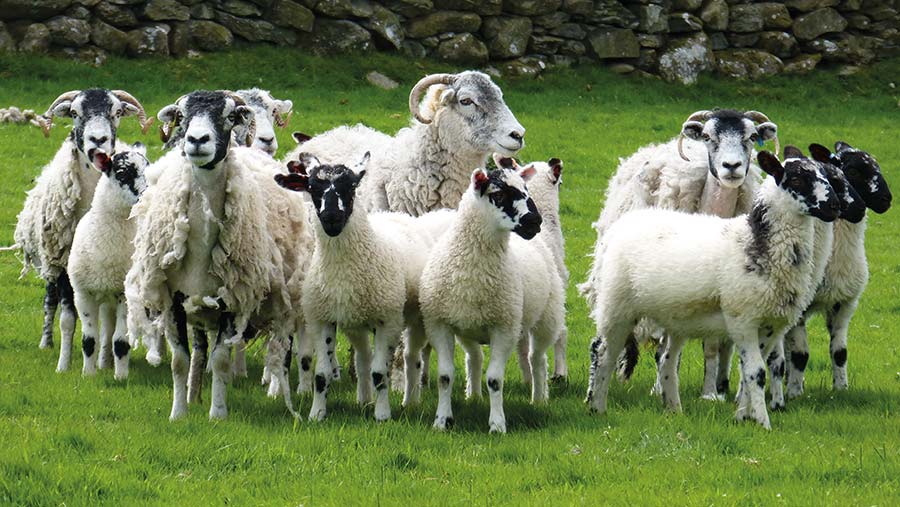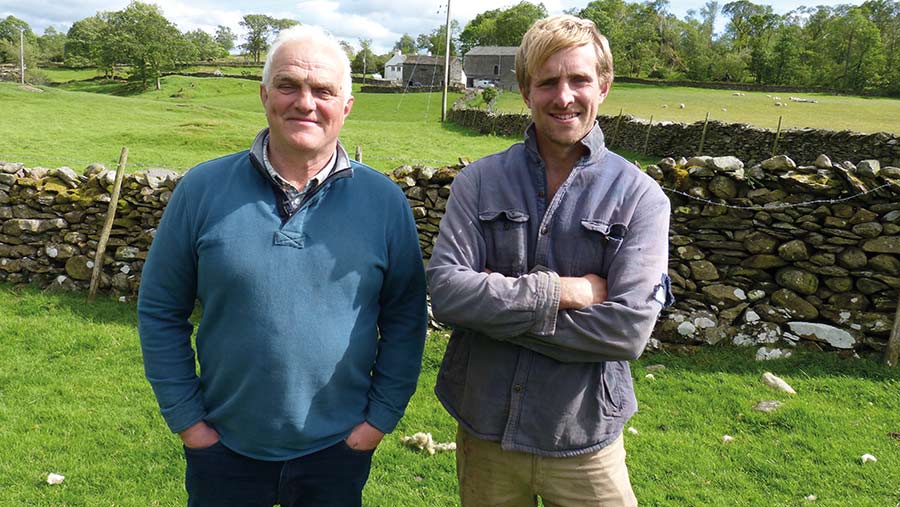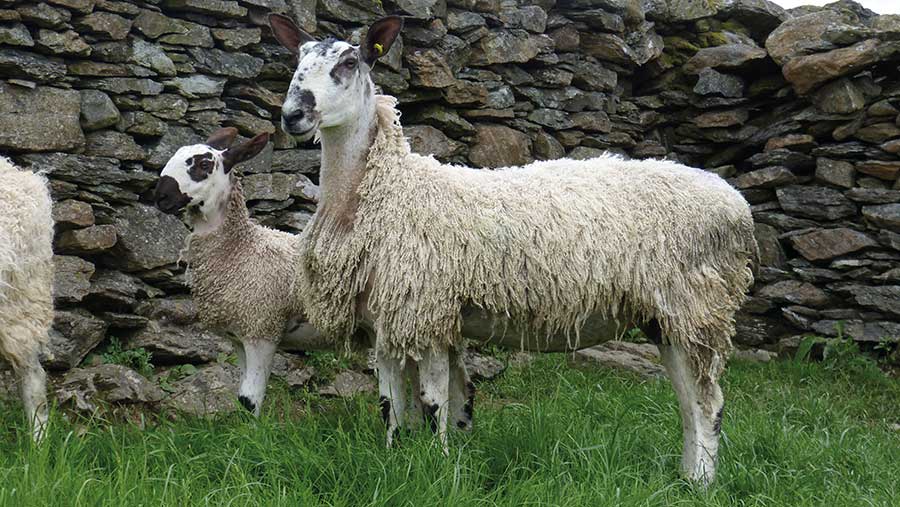Mule breeder builds flock health to keep market share
 © MAG/Michael Priestley
© MAG/Michael Priestley A Lake District family is breeding its own rams and screening high-risk stock for iceberg diseases to provide assurances for its Mule lamb customers.
The Hodgsons have been at High Borrans, Windermere, since 2007 and have bred North of England Mules since the 1970s.
They have recently stepped up flock health checks to compete with rival maternal breeds offering health accreditation.
A series of management decisions has been taken to improve the biosecurity and health of the 1,200-ewe flock in a bid to maintain market share long into the future.
See also: How Mules can rise to the challenge of rival sheep breeds
This aim is to reassure commercial breeding sheep buyers, and to ensure the productivity of the draft Swaledale ewes in the Mule breeding system at High Borrans, which has a 150-160% lambing rate in an outdoor system.
Farm facts: High Borrans, Windermere
- 415ha (1,027 acres) of grassland, including rough hill and good in-bye ground
- 1,200 Swaledale ewes, most of which are crossed to Bluefaced Leicester (crossing type)
- 200 Swaledales bred pure
- 35 suckler cows – Limousins to produce weaned calves and Whitebred Shorthorns for stewardship grazing on boggy ground
- 12 Bluefaced Leicester ewes plus followers
- Seven holiday cottages and one shepherd’s hut
Partnership
- High Borrans is farmed in a family partnership across three owned and two rented Lakeland farms totalling 2,940ha (7,000 acres) with more than 4,000 hill sheep (mainly Swaledales)
- Partners are brothers Christopher (Rydal), Jimmy (Hartsop Hall) and Jonathan Hodgson, together with Jonathan’s wife, Cathy, and son, Bertie
- A wedding barn is at Rydal and the business has holiday cottages at Hartsop.
Starting screening
The first iceberg disease being screened for is maedi visna (MV), an incurable and highly contagious virus that limits production and is invariably fatal.
The plan is to continue to test through blood sampling with Oakhill Vets and eventually have enough tested to qualify for “MV monitored” status (see box), rather than “MV accredited”.
This is because the extensive nature of the farm means the biosecurity requirements of the Scotland’s Rural College (SRUC) MV Accreditation Scheme cannot be met.

Jonathan Hodgson (left) and his son Bertie © MAG/Michael Priestley
But Jonathan Hodgson sees hill farming as a worthwhile trade-off, as the tough ground and climate (2m of rainfall/year) produces hardy stock that graze over 800m above sea level.
All sheep lamb outdoors, cutting down on the potential spread of MV – which researchers recently described as a “disease of housing”.
“Fresh air and grass are the best things for them,” says Jonathan. “I think the most we’ve ever had to house over a lambing is 90-odd ewes.
“We don’t vaccinate for abortion, which some might say is worthwhile doing for insurance, but outdoor lambing has its benefits as well as its challenges.”
With all Leicester ewes, rams and recipient ewes – 50 sheep in all – boasting MV-free blood tests from the SRUC laboratory, the plan is to continue testing cull ewes in the autumn to work towards MV monitored status.
Then to start testing for Johne’s and ovine pulmonary adenocarcinoma/jaagsiekte (OPA).
SRUC MV monitoring scheme requirements
- Target 20 high-risk animals – that is, thin or problem ewes – and test some cull ewes
- Test all rams (because they have direct contact with a lot of sheep)
- Test a proportion of extra animals that have lower health status, for example, ewes hefted on open fell or common grazing
- SRUC must then issue a certificate and issue a signed declaration
- Taking part in the scheme does not qualify an animal for export or accredited sections at shows and sales
Closed flocks
The Hodgsons have run closed hill flocks for 30 years and have recently cut down on the number of rams bought to improve farm biosecurity.
An elite flock of 200 Swaledale ewes breeds Swaledale tups and purebred replacements.
Jonathan and Bertie believe the biosecurity risked posed by the hefted Swaledale ewes is low as most of the grazing is on “sole fells”, so mixing with neighbouring sheep is limited.
The Hodgsons founded their Micklemoss Bluefaced Leicester flock in 2019, which is based heavily on Nunscleugh K20, with ewes bought from the Lunesdale, Feizor, Midlock and Gapshield flocks.
“Fifteen homebred Mules have been used as recipients for a flush of a K20 daughter and her mother, who was a G11 Ted daughter. K20 semen has been used through the flock.
Previously the farm spent up to £30,000 a year on tups, so breeding the farm’s own crossing Leicesters should bring financial benefits too,” explains Bertie.
“We don’t want to breed sheep that are too big. If you look at a lot of other breeds, the emphasis is on moderately sized ewes and output and profit per hectare, so that’s what we are hoping we can help our customers achieve,” he says.

The Bluefaced Leicester flock was started last year © MAG/Michael Priestley
“We are trying to breed something with a good body, a tight skin, good locomotion and long-lasting teeth.”
The draft Swaledale ewes come to High Borrans from the partnership’s hill farms as four-crop ewes, with sheep typically lasting another three years at High Borrans.
“We had one Swaledale that gave 12 sets of twins. That is exceptional for us, but we like to think we are breeding sheep that last well,” Bertie says.
Flock health plan
In addition to iceberg diseases, the Hodgsons keep a close eye on parasites and have an annual vet visit to review their flock health plan.
Faecal egg counts are done through the summer to influence worming decisions, and coccidiosis blocks are used to help lambs thrive. A post-mortem service is used to monitor unexplained deaths.
A strict quarantine policy is in place whereby incoming rams are isolated in a pen for at least two weeks and given an orange Monepantel wormer.
The Hodgsons find this highly effective due to it being heavily regulated and relatively new to the market.
All lambs are vaccinated for Pasteurella and clostridials and marketed as such when sold at North West Auctions’ Junction 36 site, either as breeding Mule lambs through the North of England Mule Sheep Association sale or as store wethers.
The future
The Hodgsons recognise the selling points of other breeds, but say the Mule boasts hybrid vigour, versatility and maternal ability.
“We hope this approach to flock health will get us a premium at sales, and potentially be a niche market as Mules with high health status are excellent as recipients for embryo transfer work,” says Jonathan.
Breeding sheep prices lifted last year, but only enough to make up for a 25% drop in Basic Payment Scheme (BPS) money, he adds.
This means the income from the 800-1,000 Mule gimmers they sell annually will remain critical to the business.
